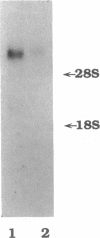Abstract
A human keratinocyte cDNA expression library in bacteriophage lambda gt11 was screened with the purified IgG fraction of serum from a patient with epidermolysis bullosa acquisita, which had a high titer of anti-type VII collagen antibodies. Screening of approximately 3 x 10(5) plaques identified 8 positive clones, the largest one (K-131) being approximately 1.9 kilobases in size. Dideoxynucleotide sequencing of K-131 indicated that it consisted of 1875 base pairs and contained an open reading frame coding for a putative N-terminal noncollagenous domain of 439 amino acids and a collagenous C-terminal segment of 186 amino acids. The collagenous domain was characterized by repeating Gly-Xaa-Yaa sequences that were interrupted in several positions by insertions or deletions of 1-3 amino acids. The deduced amino acid sequence also revealed a peptide segment that had a high degree of identity with a published type VII collagen protein sequence. Northern hybridization of the K-131 cDNA with human epidermal keratinocyte and skin fibroblast RNA revealed an mRNA of approximately 8.5 kilobases. The fusion protein produced by the K-131 cDNA, when incubated with epidermolysis bullosa acquisita serum, bound to antibodies that reacted in Western blots with type VII collagen. The genomic location of the type VII collagen gene (COL7A1) was determined by chromosomal in situ hybridization with the K-131 cDNA. The results mapped the COL7A1 to the locus 3p21. The cDNA clones characterized in this study will be valuable for understanding the protein structure and gene expression of type VII collagen present in anchoring fibrils and its aberrations in the dystrophic forms of heritable epidermolysis bullosa.
Full text
PDF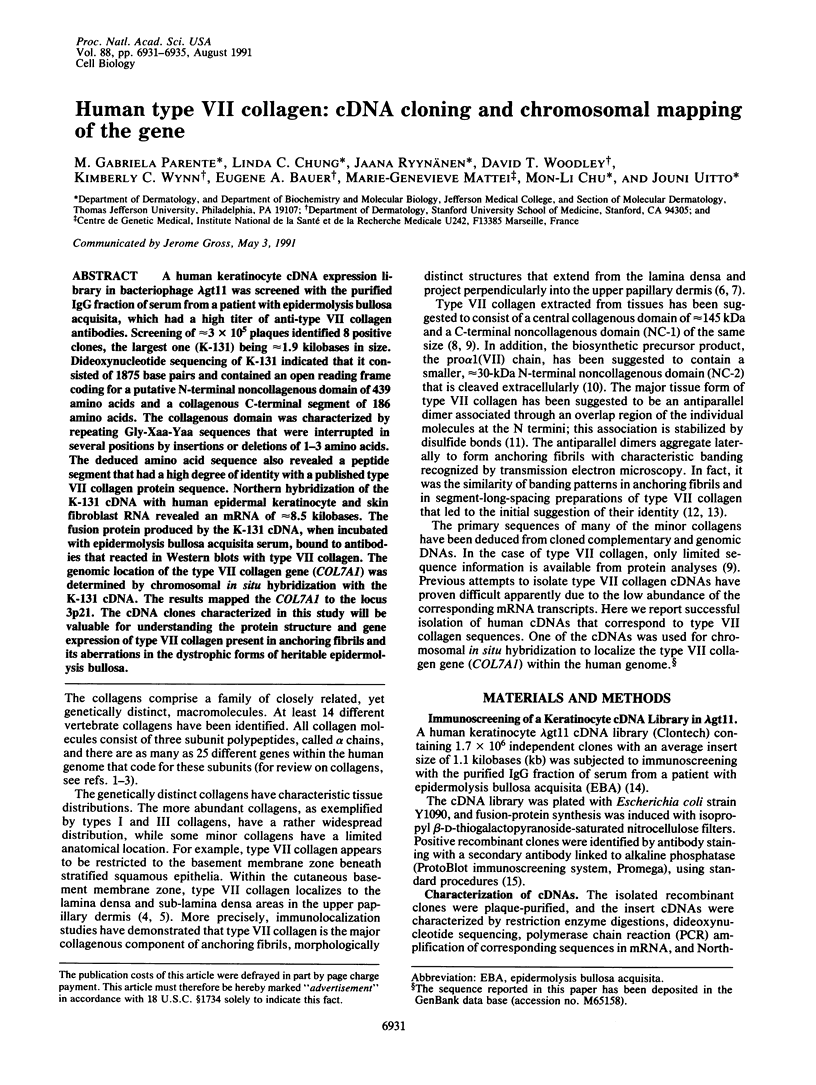
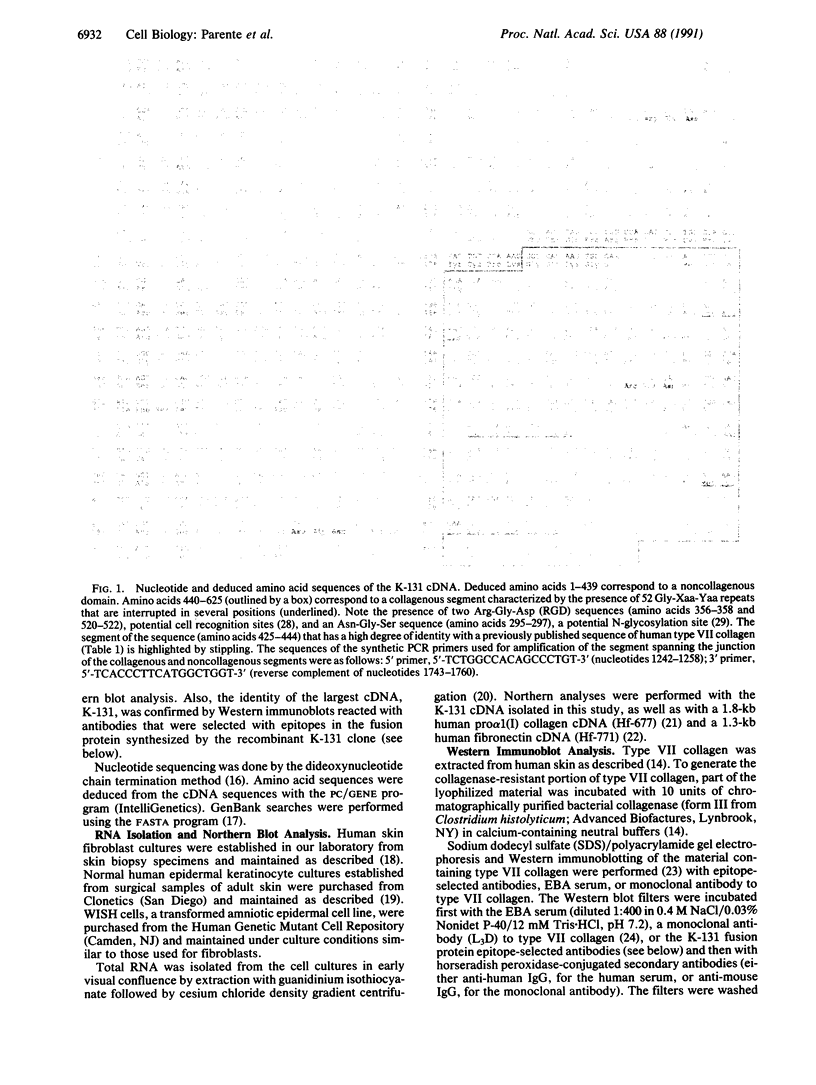
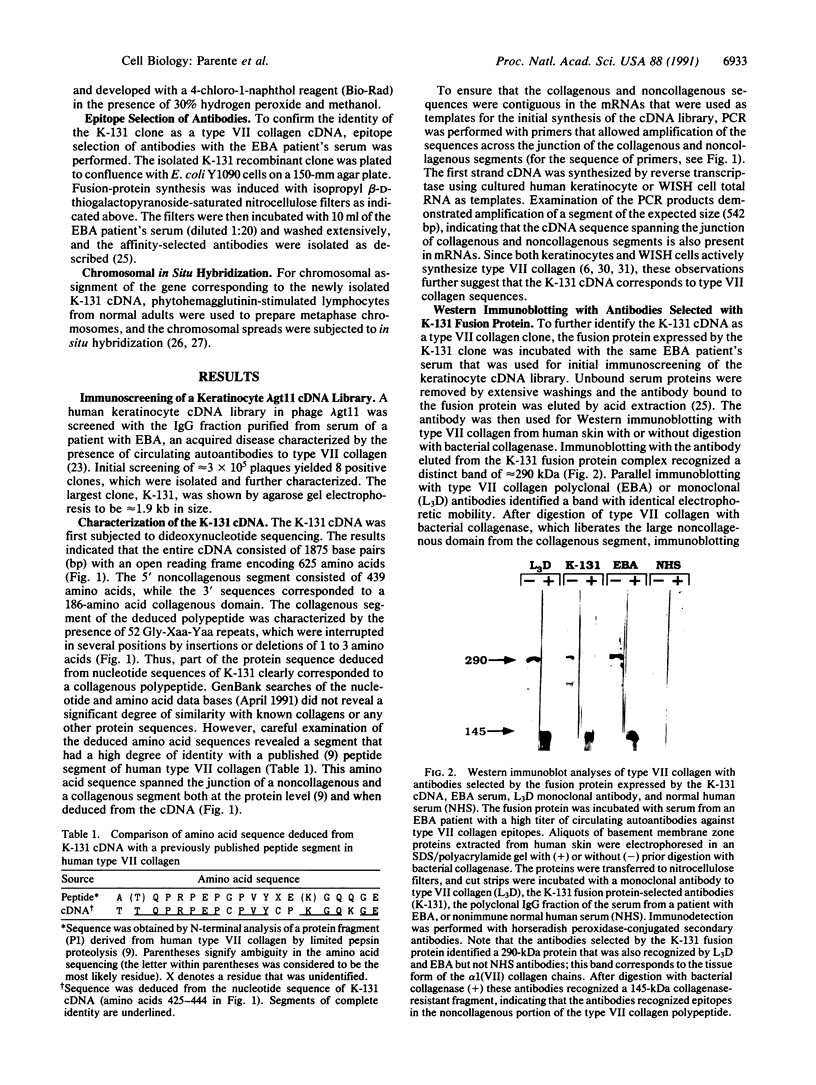
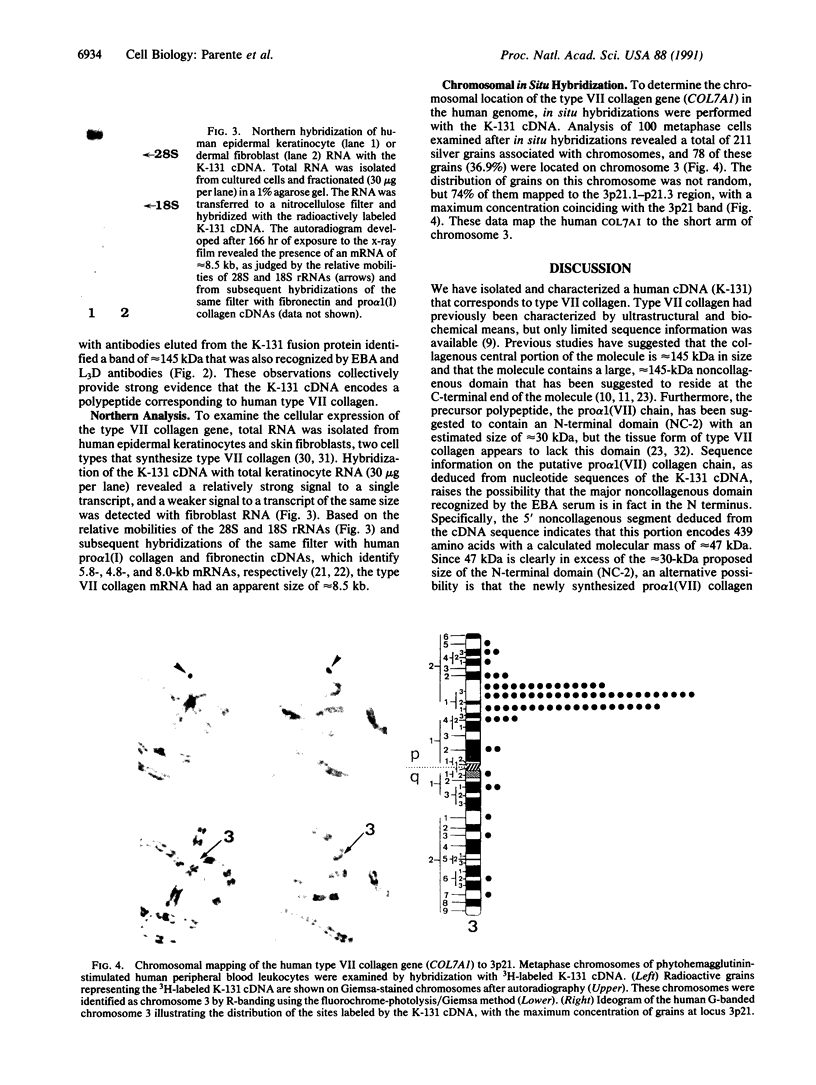
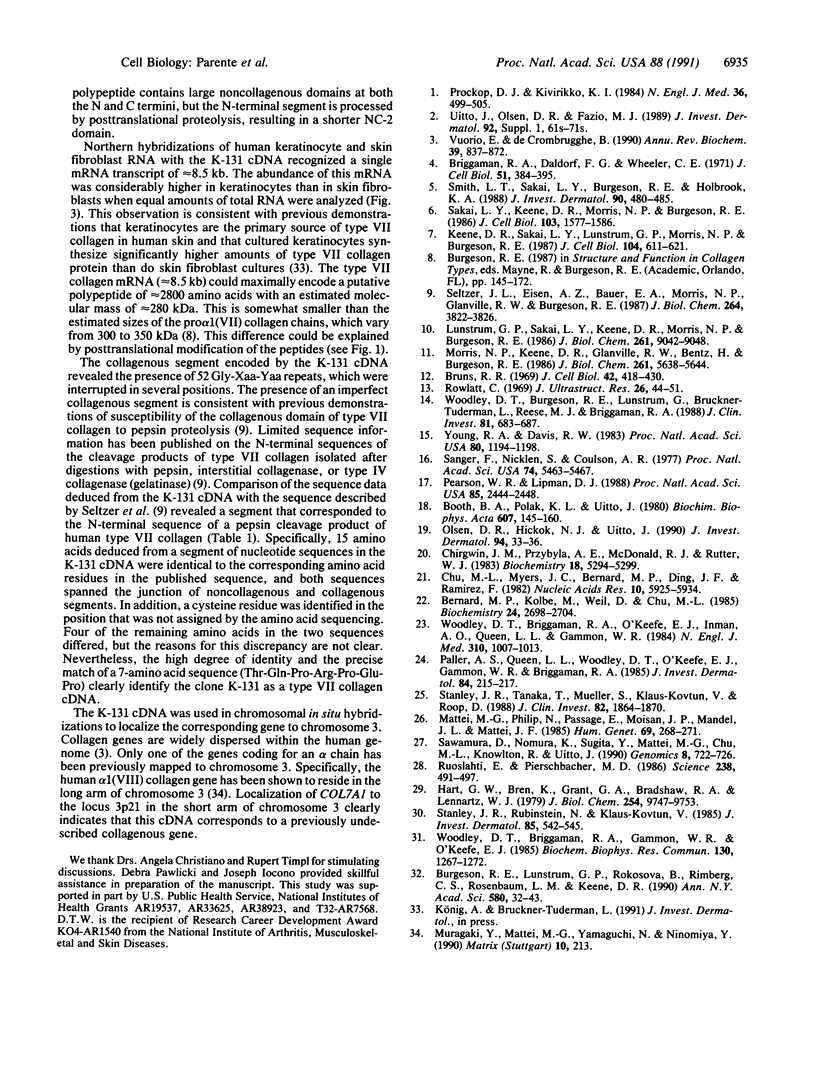
Images in this article
Selected References
These references are in PubMed. This may not be the complete list of references from this article.
- Bernard M. P., Kolbe M., Weil D., Chu M. L. Human cellular fibronectin: comparison of the carboxyl-terminal portion with rat identifies primary structural domains separated by hypervariable regions. Biochemistry. 1985 May 21;24(11):2698–2704. doi: 10.1021/bi00332a016. [DOI] [PubMed] [Google Scholar]
- Booth B. A., Polak K. L., Uitto J. Collagen biosynthesis by human skin fibroblasts. I. Optimization of the culture conditions for synthesis of type I and type III procollagens. Biochim Biophys Acta. 1980 Mar 28;607(1):145–160. doi: 10.1016/0005-2787(80)90228-2. [DOI] [PubMed] [Google Scholar]
- Briggaman R. A., Dalldorf F. G., Wheeler C. E., Jr Formation and origin of basal lamina and anchoring fibrils in adult human skin. J Cell Biol. 1971 Nov;51(21):384–395. doi: 10.1083/jcb.51.2.384. [DOI] [PMC free article] [PubMed] [Google Scholar]
- Bruns R. R. A symmetrical, extracellular fibril. J Cell Biol. 1969 Aug;42(2):418–430. doi: 10.1083/jcb.42.2.418. [DOI] [PMC free article] [PubMed] [Google Scholar]
- Burgeson R. E., Lunstrum G. P., Rokosova B., Rimberg C. S., Rosenbaum L. M., Keene D. R. The structure and function of type VII collagen. Ann N Y Acad Sci. 1990;580:32–43. doi: 10.1111/j.1749-6632.1990.tb17915.x. [DOI] [PubMed] [Google Scholar]
- Chirgwin J. M., Przybyla A. E., MacDonald R. J., Rutter W. J. Isolation of biologically active ribonucleic acid from sources enriched in ribonuclease. Biochemistry. 1979 Nov 27;18(24):5294–5299. doi: 10.1021/bi00591a005. [DOI] [PubMed] [Google Scholar]
- Chu M. L., Myers J. C., Bernard M. P., Ding J. F., Ramirez F. Cloning and characterization of five overlapping cDNAs specific for the human pro alpha 1(I) collagen chain. Nucleic Acids Res. 1982 Oct 11;10(19):5925–5934. doi: 10.1093/nar/10.19.5925. [DOI] [PMC free article] [PubMed] [Google Scholar]
- Hart G. W., Brew K., Grant G. A., Bradshaw R. A., Lennarz W. J. Primary structural requirements for the enzymatic formation of the N-glycosidic bond in glycoproteins. Studies with natural and synthetic peptides. J Biol Chem. 1979 Oct 10;254(19):9747–9753. [PubMed] [Google Scholar]
- Keene D. R., Sakai L. Y., Lunstrum G. P., Morris N. P., Burgeson R. E. Type VII collagen forms an extended network of anchoring fibrils. J Cell Biol. 1987 Mar;104(3):611–621. doi: 10.1083/jcb.104.3.611. [DOI] [PMC free article] [PubMed] [Google Scholar]
- Lunstrum G. P., Sakai L. Y., Keene D. R., Morris N. P., Burgeson R. E. Large complex globular domains of type VII procollagen contribute to the structure of anchoring fibrils. J Biol Chem. 1986 Jul 5;261(19):9042–9048. [PubMed] [Google Scholar]
- Mattei M. G., Philip N., Passage E., Moisan J. P., Mandel J. L., Mattei J. F. DNA probe localization at 18p113 band by in situ hybridization and identification of a small supernumerary chromosome. Hum Genet. 1985;69(3):268–271. doi: 10.1007/BF00293038. [DOI] [PubMed] [Google Scholar]
- Morris N. P., Keene D. R., Glanville R. W., Bentz H., Burgeson R. E. The tissue form of type VII collagen is an antiparallel dimer. J Biol Chem. 1986 Apr 25;261(12):5638–5644. [PubMed] [Google Scholar]
- Olsen D. R., Hickok N. J., Uitto J. Suppression of ornithine decarboxylase gene expression by retinoids in cultured human keratinocytes. J Invest Dermatol. 1990 Jan;94(1):33–36. doi: 10.1111/1523-1747.ep12873328. [DOI] [PubMed] [Google Scholar]
- Paller A. S., Queen L. L., Woodley D. T., Gammon W. R., O'Keefe E. J., Briggaman R. A. A mouse monoclonal antibody against a newly discovered basement membrane component, the epidermolysis bullosa acquisita antigen. J Invest Dermatol. 1985 Mar;84(3):215–217. doi: 10.1111/1523-1747.ep12265158. [DOI] [PubMed] [Google Scholar]
- Pearson W. R., Lipman D. J. Improved tools for biological sequence comparison. Proc Natl Acad Sci U S A. 1988 Apr;85(8):2444–2448. doi: 10.1073/pnas.85.8.2444. [DOI] [PMC free article] [PubMed] [Google Scholar]
- Rowlatt C. Subepithelial fibrils associated with the basal lamina under simple epithelia in mouse uterus: possible tropocollagen aggregates. J Ultrastruct Res. 1969 Jan;26(1):44–51. doi: 10.1016/s0022-5320(69)90034-3. [DOI] [PubMed] [Google Scholar]
- Ruoslahti E., Pierschbacher M. D. New perspectives in cell adhesion: RGD and integrins. Science. 1987 Oct 23;238(4826):491–497. doi: 10.1126/science.2821619. [DOI] [PubMed] [Google Scholar]
- Sakai L. Y., Keene D. R., Morris N. P., Burgeson R. E. Type VII collagen is a major structural component of anchoring fibrils. J Cell Biol. 1986 Oct;103(4):1577–1586. doi: 10.1083/jcb.103.4.1577. [DOI] [PMC free article] [PubMed] [Google Scholar]
- Sanger F., Nicklen S., Coulson A. R. DNA sequencing with chain-terminating inhibitors. Proc Natl Acad Sci U S A. 1977 Dec;74(12):5463–5467. doi: 10.1073/pnas.74.12.5463. [DOI] [PMC free article] [PubMed] [Google Scholar]
- Sawamura D., Nomura K., Sugita Y., Mattei M. G., Chu M. L., Knowlton R., Uitto J. Bullous pemphigoid antigen (BPAG1): cDNA cloning and mapping of the gene to the short arm of human chromosome 6. Genomics. 1990 Dec;8(4):722–726. doi: 10.1016/0888-7543(90)90261-r. [DOI] [PubMed] [Google Scholar]
- Seltzer J. L., Eisen A. Z., Bauer E. A., Morris N. P., Glanville R. W., Burgeson R. E. Cleavage of type VII collagen by interstitial collagenase and type IV collagenase (gelatinase) derived from human skin. J Biol Chem. 1989 Mar 5;264(7):3822–3826. [PubMed] [Google Scholar]
- Smith L. T., Sakai L. Y., Burgeson R. E., Holbrook K. A. Ontogeny of structural components at the dermal-epidermal junction in human embryonic and fetal skin: the appearance of anchoring fibrils and type VII collagen. J Invest Dermatol. 1988 Apr;90(4):480–485. doi: 10.1111/1523-1747.ep12460951. [DOI] [PubMed] [Google Scholar]
- Stanley J. R., Rubinstein N., Klaus-Kovtun V. Epidermolysis bullosa acquisita antigen is synthesized by both human keratinocytes and human dermal fibroblasts. J Invest Dermatol. 1985 Dec;85(6):542–545. doi: 10.1111/1523-1747.ep12277377. [DOI] [PubMed] [Google Scholar]
- Stanley J. R., Tanaka T., Mueller S., Klaus-Kovtun V., Roop D. Isolation of complementary DNA for bullous pemphigoid antigen by use of patients' autoantibodies. J Clin Invest. 1988 Dec;82(6):1864–1870. doi: 10.1172/JCI113803. [DOI] [PMC free article] [PubMed] [Google Scholar]
- Vuorio E., de Crombrugghe B. The family of collagen genes. Annu Rev Biochem. 1990;59:837–872. doi: 10.1146/annurev.bi.59.070190.004201. [DOI] [PubMed] [Google Scholar]
- Woodley D. T., Briggaman R. A., Gammon W. R., O'Keefe E. J. Epidermolysis bullosa acquisita antigen is synthesized by human keratinocytes cultured in serum-free medium. Biochem Biophys Res Commun. 1985 Aug 15;130(3):1267–1272. doi: 10.1016/0006-291x(85)91751-6. [DOI] [PubMed] [Google Scholar]
- Woodley D. T., Briggaman R. A., O'Keefe E. J., Inman A. O., Queen L. L., Gammon W. R. Identification of the skin basement-membrane autoantigen in epidermolysis bullosa acquisita. N Engl J Med. 1984 Apr 19;310(16):1007–1013. doi: 10.1056/NEJM198404193101602. [DOI] [PubMed] [Google Scholar]
- Woodley D. T., Burgeson R. E., Lunstrum G., Bruckner-Tuderman L., Reese M. J., Briggaman R. A. Epidermolysis bullosa acquisita antigen is the globular carboxyl terminus of type VII procollagen. J Clin Invest. 1988 Mar;81(3):683–687. doi: 10.1172/JCI113373. [DOI] [PMC free article] [PubMed] [Google Scholar]
- Young R. A., Davis R. W. Efficient isolation of genes by using antibody probes. Proc Natl Acad Sci U S A. 1983 Mar;80(5):1194–1198. doi: 10.1073/pnas.80.5.1194. [DOI] [PMC free article] [PubMed] [Google Scholar]





